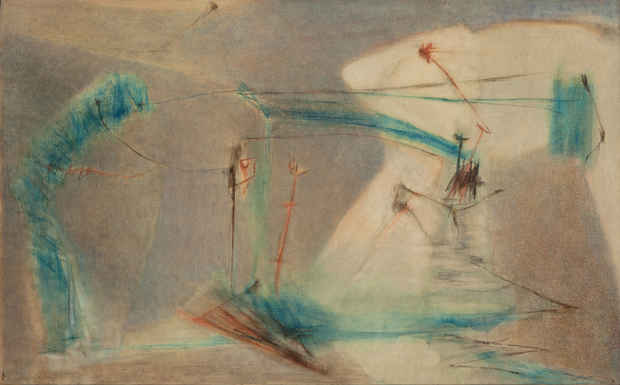Bernard Childs "1950s"
Jason McCoy, Inc. (Midtown)

This event has ended.
The work of Bernard Childs spans almost four decades. It truly begins after Childs returned from World War II, having spent three years in the Navy aboard a destroyer escort in the South Pacific and having been in hospitals twice thereafter. Years later, he reflected: “I did not get back to the world until October 1948. But those five years were invaluable. They gave me back to myself.” Childs belonged to a generation whose contact with war forever meant a finite break with the world previously known, or the life that had come with it. By the 1950s, when Childs matured as an artist, he was eager to carve out his vision without time or patience left for compromises.
To view Childs’ works from the 1950s through the early 1980s means to move through chapters. In many ways he remained most comfortable out in the world, without permanent geographical ties. Much of his visual vocabulary, ranging from abstract and mythically veiled to figurative, is rooted in his travels. In 1951, he headed for Europe, first to Italy, then, settling in Paris. The paintings of the 1950s, such as "Le Forêt" {sic}, (1953) reveal his search for atmospheric light, perhaps a reflection of the distinct changes between the seasons. In part, they also speak of the more subtle transitions between natural and urban landscapes that he encountered in Europe versus the stark contrasts in New York. By the late 1950s, by then middle aged, Childs had reached critical acclaim. The decade culminated with a solo exhibition at the Stedelijk Museum in Amsterdam (1959).
In the early 1960s, Childs was invited to exhibit in Japan. In the course of six months, he had two Tokyo gallery exhibitions. While there he began to experiment with a variety of unexpected materials. In the following years, he often employed sand, carborundum, and even brick dust to create texture. Structurally, works, such as "Carmen" (1962), evolve around geometric shapes that from a distance read as graphically flat, but upon close inspection feature heavy impasto. None of Childs’ paintings reveal themselves quickly. His unique sense of layering, compositionally but also intellectually, makes for faceted discoveries. His works are meant to be observed from afar, as well as up close; they can be taken in as a whole or studied section by section. From 1966 to 1977 Childs commuted between his studios in Paris and the Chelsea Hotel in New York. In that time, he developed a keen interest in environmental issues. Scientific discoveries of the time led him to consider the possible catastrophic destruction of our planet. He meditated on distant worlds and ancient forms of life, such as insects, which became symbols of survival for him. Paired with a vibrant palette that originated in a Mid-summer spent in Stockholm, Childs’ paintings of the 1970s, including "Outrider," 1972, fuse his fascination with science fiction, technology, space exploration and the survival of unexpected species of life. While Childs’ oeuvre is defined by multiple currents, it also exhibits one cohesive through-line. Each work imbues an unmistakable sense of intimacy. We encounter a sense of longing, a poetic or emotional reaching for the fleeting moment that is life. It comes enveloped in a language both tranquil and hypnotic.
After a stroke in 1978, Childs settled in New York for good. His last paintings are characterized by simplified shapes, which tell of his lifelong exploration of unusual formal and color relationships. Only a few years before his death, Childs created his only self-portrait (1982). Instead of looking directly at the viewer, we find him gazing over his right shoulder. It instills the impression of a man who is confident in the journey he pursued. This image goes well with a reflection Childs offered towards the end of his life: “If I belong to any school, it is the one of the peripatetics, which I have come to call “the school of displacement.” It is not a way of looking for one’s self. It is the process of becoming oneself.”
[Image: Bernard Childs "Entre Deux" (1953) oil on linen 35 x 51 in.]
Media
Schedule
from February 13, 2013 to March 08, 2013
Closing Reception on 2013-02-20 from 18:00 to 20:00